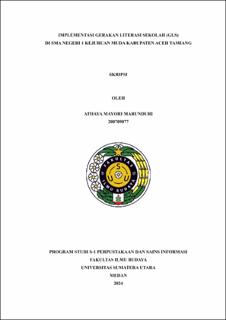| dc.description.abstract | The School Literacy Movement is a government initiative to improve student
literacy in Indonesia. This research investigated the implementation of the School
Literacy Movement (GLS) in State Senior High School 1 Kejuruan Muda, Aceh
Tamiang District. A purposive sampling approach was used to select ten key
informants, including the school principal, vice principal overseeing curriculum,
librarian, Bahasa Indonesia teachers, and senior students from grade 12. The
research employed a descriptive qualitative design with data collection through
observation and interviews. Data analysis techniques involved data reduction,
presentation, and conclusion drawing. The research drew its theoretical framework
from the Ministry of Education and Culture's 2016 Guide for implementing the
School Literacy Movement (GLS) in Senior High School (SMA). The research
indicators aligned with the three stages of the GLS program: habituation,
development, and learning. The research findings indicated that the habituation
stage of the School Literacy Movement (GLS) at State Senior High School 1
Kejuruan Muda had been implemented in accordance with the guidelines, as
evidenced by the regular 15-minute reading activities. During the development
stage, the school employed strategies to enhance student engagement by
introducing awards for active participation in the 15-minute reading activities and
library visits. However, the learning stage lacked follow-up activities, special
awards, or academic credit. The research revealed that the habituation stage faced
challenges due to the lack of variation in the 15-minute silent reading activities and
the limited book collection in the reading corners, leading to boredom and
disengagement among students. The development stage encountered obstacles in
the implementation of the GELIAT RIA program, which had become less consistent.
Consequently, the learning stage lacked academic-based assessments. | en_US |


